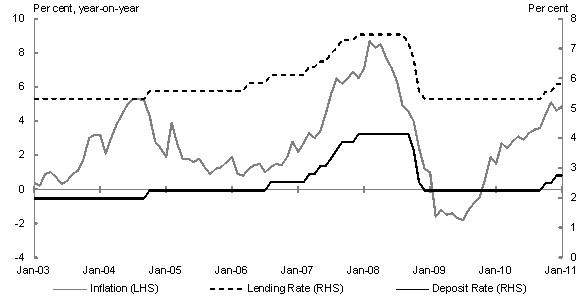The stimulus supported growth through the crisis; but, as China unwinds the 2-3 per cent boost to GDP from the package, the challenge is how to maintain growth. Continuing to pull on the levers that supported growth over 2009 and 2010 would likely exacerbate growing imbalances in the economy.
While pumping liquidity into the economy supported China through the crisis, there are increasing signs of excess liquidity. Property prices have reached levels well beyond the reach of average income earners in some of China's major cities, such as Beijing and Shanghai, leading to concerns of a property price bubble. Speculative investment has appeared in areas as obscure as tea and garlic as investors seek returns through capital gains across the economy.
Consumer price inflation exceeded the 3.0 per cent target for 2010, reaching 4.6 per cent year-on-year in December 2010. It is clear that the Central Government will need to quell the tide of excess liquidity in the economy if it wants to avoid excessively high inflation and over-inflated asset prices. In response to these pressures, monetary policy has already been tightened to unwind the amount of stimulus. RRRs have been raised to record levels and interest rates are being raised gradually.
The Central Government began to raise interest rates in late 2010. However, interest rates for deposits remain below the rate of inflation—a situation that has existed for a number of years (see Chart 7). While real deposit rates remain negative, there will be incentives to invest in assets in pursuit of capital gains, particularly in the property sector.
Chart 7: Inflation, lending, and deposit rates

Source: CEIC Data 1990-2011.
Exchange rate policy will also be important. China's real effective exchange rate is adjusting, but much of the adjustment continues to be through domestic prices and wages. The Central Government is carefully controlling the pace at which the nominal exchange rate appreciates. The cost of a gradual nominal exchange rate adjustment is that China will continue to accumulate foreign reserves, making it even more difficult to control liquidity, fuelling inflation pressures. It also makes China susceptible to speculative capital flows attracted by expected appreciation of the RMB. To help combat inflation, the Central Government may need to reassess the speed at which it allows the nominal exchange rate to adjust.
In respect of fiscal policy, the Central Government continues to have fiscal room to support growth, although there may be limits on the ability of local governments to continue to fund investment. Local governments must continue to pursue property sales as a source of revenue growth or increase debt if they are to maintain momentum in infrastructure investment. Relying on property sales has its limits and could add fuel to the overheating property sector. Excessive reliance on debt leads to concerns about the possibility of non-performing loans (NPLs). The CBRC has indicated that RMB 1.76 trillion out of RMB 7.66 trillion of the local government financing vehicles loans in June 2010 were at risk of default (www.chinanews.com, 2010).
NPLs are likely to increase, with most outstanding debts ultimately falling upon the Central Government. This is because the NPLs will largely belong to government banks offering loans to LGFVs. With the Chinese Government working under a single hierarchy, any debts in the government-owned banks and local governments will ultimately be passed to the Central Government.
While the Central Government can monitor most large debts by its agencies, some debts are harder to keep under surveillance. Major categories of government debt that can be monitored through government sources or bond markets include Central Government debt (17 per cent of GDP), local government financing vehicle debt (19 per cent of GDP), policy bank debt (13 per cent of GDP), and the Ministry of Railways debt (1.3 per cent of GDP). These debts sum to about 50 per cent of GDP. While other smaller debts are expected to exist within the Chinese Government hierarchy, it is difficult to determine their size. That said, these debts are not believed to be large, and overall total government debt is estimated to be in the range of 60-70 per cent of GDP.
While Central Government debt is small, the growth in contingent liabilities from other forms of public debt could ultimately become a constraint. This does not appear to be the case at present and fiscal policy will continue to support activity in the short term. During the Central Government's Economic Work Conference in December 2010, the Chinese leadership stated that their priority for 2011 is to ‘actively and properly handle the relations between maintaining steady and relatively fast economic growth, economic restructuring and managing inflation expectations'. The Central Government said that this priority will be achieved in 2011 through implementing prudent monetary policy and pro-active fiscal policy.